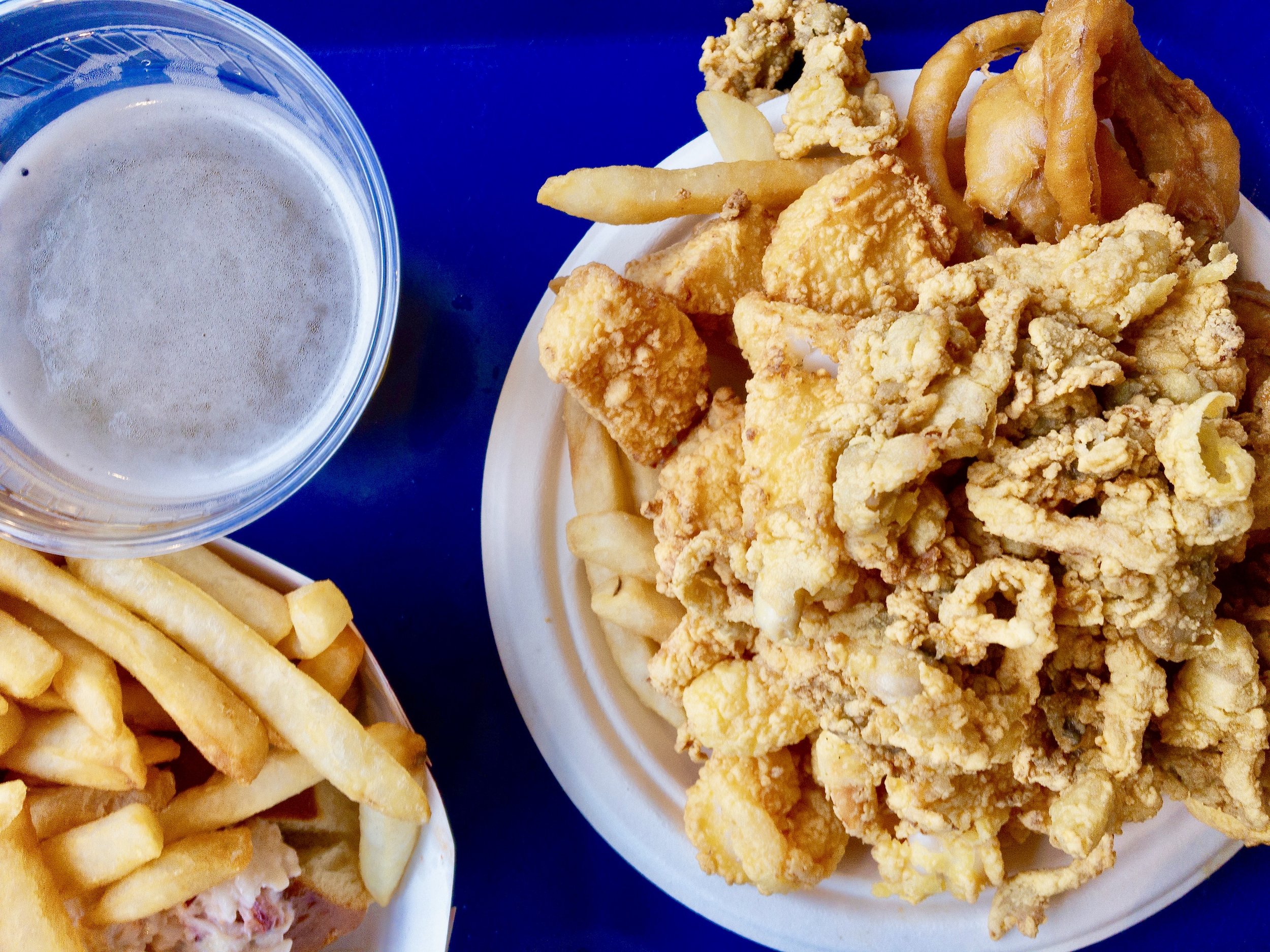Ipswich Fried Clams
Illustration: Chelsea Damraksa
Words and Photo by Kelsey Tenney
In 1914, for the very first time, an Ipswich clam was dunked into a bowl of evaporated milk, dusted in corn flour and then deep-fried in lard. In a moment of epiphany for Bessie and Chubby Woodman, clams were added to their potato chip fryer, and the result was not only a delicious delicacy, but local clam diggers now had another outlet for their harvest and could make a better living. That tradition continues to this day to wonderful success.
Woodman’s of Essex is on its third generation of family owners and its popularity is still widespread. During the warm months, lines of diners wrap around the building, rain or shine. Steve, one of the grandsons of the original Woodman founders and current co-owner, is helping to keep the legacy of Woodman’s alive.
Steve claims the recipe of their fried clams is the same as as it was on that July day in 1914. First, whole belly soft shell clams are dipped in evaporated milk, followed quickly by 100% corn flour. The evaporated milk is just thick enough to adhere the coating in a thin layer. The corn flour (not cornmeal) adds a subtle crispiness and a slightly sweet flavor to highlight the briny, savory clam bellies. The prepped clams are then fried in a vat of lard, which stands up better to high heat than unsaturated frying oils and lends a cleaner flavor.
In contrast, some other purveyors in the area—like Charlie’s Seafood in Lynn—use a blend of corn flour and white wheat flour which creates a mixture more like the breading of other fried foods, but the subtle sweetness from the corn is still there. The lower amount of sugar in the wheat flour also prevents the clam from getting too dark in color. Still others use cornmeal to coat their clams—a course grind compared to the finer corn flour. This makes the clams more crunchy and the corn flavor more intense.
Even a casual clam enthusiast will argue about which clam shop is their go-to—between Woodman’s, The Clam Box, JT Farnham’s and more. Real diehards will also tell you to avoid “clam strips.” Whole belly soft shell clams are full of the natural flavor of the sea. Sweet, briny and almost creamy in the middle, whole belly clams are the sum of their parts: a rich, savory interior combined with a crunchy fried exterior crust that makes them irresistible. In contrast, clam strips are cut pieces of hard-shelled sea clam. They have much less flavor and less risk of a funky surprise, which some diners prefer, but their texture is more elastic and rubbery. These larger, tougher clams are commonly chopped for use in chowder, but Howard Johnson popularized fried clam strips across America in the 1930s thanks to a clever Ipswich entrepreneur. Whole belly clams are what make the Boston area famous for its fried clams, so stick to the classic and you can’t go wrong.
There’s more to the story than selection and preparation. The North Shore of Boston is home to a robust clam and shellfish industry due to its predominant tidal mud flats. Steve Kirk, a shellfish conservationist from The Nature Conservancy, cast some light on this environmental phenomenon. Mud flats on these shores—in contrast to sand flats found elsewhere—have a unique makeup of minerals, saltier water and a fluctuating ocean current that make the clams’ flavor richer and sweeter with less residual sediment. Additionally, a thriving estuary must also contain adult clams to spawn new clams and a suitable environment to nurture the babies, so these soft-shell clams are dug by hand with strict limits. Kirk explained that the “generational lore and presence of clams in the culture [has also] played as much of a role” in ensuring the clamming sector has remained alive and well across the centuries.
But bountiful annual harvests of Ipswich, Essex and Plum Island soft shells are fewer and further between. Kirk explained that there are various environmental factors stressing the estuary, like ocean acidification, water quality and nitrogen pollution which can result in mud flats being more acidic, challenging early stages of shellfish life. As a result, Maine has become the second-choice supplier of soft shell clams. Another factor is the recent appearance of the predatory green crab, which has a “voracious appetite” for soft shell clams, according to Kirk. The Division of Marine Fisheries (DMF) manages the clam populations and other near-shore shellfish. According to Ryan Joyce, a shellfish biologist for the DMF, they are working with towns to help ensure these species have the habitat to thrive and be eaten safely, providing technical assistance for shellfish seeding (putting clams grown in a hatchery into the mud flats to encourage population growth) and regular water quality checks.
Whole belly fried clams in New England are the definition of food with a sense of place. The invention of the fried clam, the heritage of their existence, the roadside-stand-cult-following and the unique tidal environment that grows the sweetest soft shell clams all adds up to a borderline-legendary status. “Soft shell clams are the identity of the North Shore” Kirk described. “Clams are king on the North Shore.”
Today, fried clams are still at the forefront of New England fare—especially during the summer months when these roadside stands dominate the landscape. Woodman’s of Essex is still operating today with the third generation at the helm, and many other restaurants, town governments and conservationists are doing their best to keep the tradition of fried clams alive. Be sure to get out there now to catch a basket before the summer ends!
Woodman’s of Essex
978.768.6451
Charlie’s Seafood of Lynn
781.595.8953
The Clam Box of Ipswich
978.356.9707
J.T. Farnhams
978.768.6643
This article appeared in the summer of 2019 as an online exclusive.


